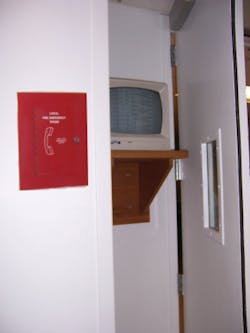A reader from Ohio wrote: "I'm always running into trouble over how many horns and strobe lights are necessary. Is occupant notification always required?"
No, building-wide occupant notification is not always required, but some kind of notification is always required. NFPA 72 provides rules for when a fire alarm system does not need to notify all building occupants of the need to evacuate. In those cases, you will have the option to provide what is known as "Private Operating Mode" notification. NFPA defines this as "Audible or visible signaling only to those persons directly concerned with the implementation and direction of emergency action initiation and procedure in the area protected by the fire alarm system." Although building and fire codes are primarily concerned with occupant safety, there are going to be several instances where general occupant notification is not desirable. This is usually where the general population (or a large part of it) is incapable of self-rescue, due to their physical or mental condition.
Hospitals and nursing homes are examples of these occupancy types. Inspectors and codes will certainly allow private mode notification in the patient areas; yet in the public and common use areas, such as the cafeteria, gift shop, offices and main hallways, the requirement for public mode notification will prevail. The logic for this is that many of those in a healthcare facility cannot walk. Various conditions and sedatives may cause some patients to not even wake-even if a horn was sounding directly over their bed. In other cases, sudden loud noises and flashing lights can cause much anxiety and overreaction by certain patients and their visitors.
Public versus private annunciation modes
There is a passage in NFPA 72, 2010 that states private mode annunciators must be kept from the public's view and that of the general population: "18.9.3.1 Private Mode. Unless otherwise permitted by the authority having jurisdiction, all textual visible notification appliances in the private mode shall be located in rooms that are accessible only to those persons directly concerned with the implementation and direction of emergency action initiation and procedure in the areas protected by the system."
Jails and detention centers are other examples where general notification through the use of horns and strobes is not required. The building codes only require that the staff be notified upon activation of waterflow, smoke detection or manual devices. Since these residents are not permitted to go anywhere without strict security measures being taken by the staff, there is no point in adding to the noise and confusion by sounding horns and flashing lights.
Other opportunities for sounders
Another opportunity to use Private Mode notification is when a fire alarm system isn't required by the building or fire code. For example, if your customer is installing automatic detection for the protection of property, it makes sense that they will not be providing general occupant notification. You can safely sell additional protection using smoke/heat detectors wired to your customer's dual-listed fire-security panel.
In this case, the owner is the AHJ and the level of protection is up to them, not the local building/fire official. (Time out for a rant! OK, before you start to e-mail me about how you know of a local jurisdiction that requires anyone considering adding a few fire alarm devices to their commercial fire alarm system, to do it in an 'all-or-nothing' manner, I am aware that there are locales where this is true. And yes, some of those inspectors boast about how they have forced a few restaurants or businesses wishing to add smoke detectors, to add "complete protection," but these jurisdictions are the exception.)
These jurisdictions have yet to realize the number of businesses that are choosing "nothing." I liken their "all or nothing" requirement to a situation where local officials forced all their residents who were buying new cars, to buy the safest, and most expensive, Volvo on the market or they wouldn't license the car at all. So, in areas other than these few "all or nothing" municipalities, if a building owner wishes to install automatic and manual devices for property protection, or to monitor a special-hazard suppression system activation, then they too, are allowed to operate in the Private Mode.
Locating private mode annunciators and sounders is up to the responders. NFPA 72 states "All required annunciation means shall be located as required by the authority having jurisdiction to facilitate an efficient response to the fire situation." If the owner's fire alarm system isn't required by code (i.e. it was voluntarily installed), then the annunciator(s) must be located where "those persons directly concerned with the implementation and direction of emergency action" have access to them.
Private Mode Audible notification appliances (not required to be as loud as public mode appliance) need to be located where these people directly concerned with emergency action will likely hear the alarm (thereby letting them know of the need to get to a nearby annunciator to see what's going on). The emergency plan may include using the building's voice announcement speakers or emergency sirens to make any further notifications. Even though these annunciators are not required, you should still consider placing one where the fire department can easily use it upon their arrival at the facility.
Textual notification appliances used for annunciation include vacuum fluorescent keypads, LCD display screens, video monitors and printers. These are often other types of private mode visible notification.
Private mode audible notification signals are usually chimes and/or coded signals but may also include cryptic voice announcements such as "May I have your attention, please. Code Red."
When providing the notification, remember there is no third operating mode for fire alarm notification-it's either required to be Public Mode or allowed to be Private Mode.
About the Author


